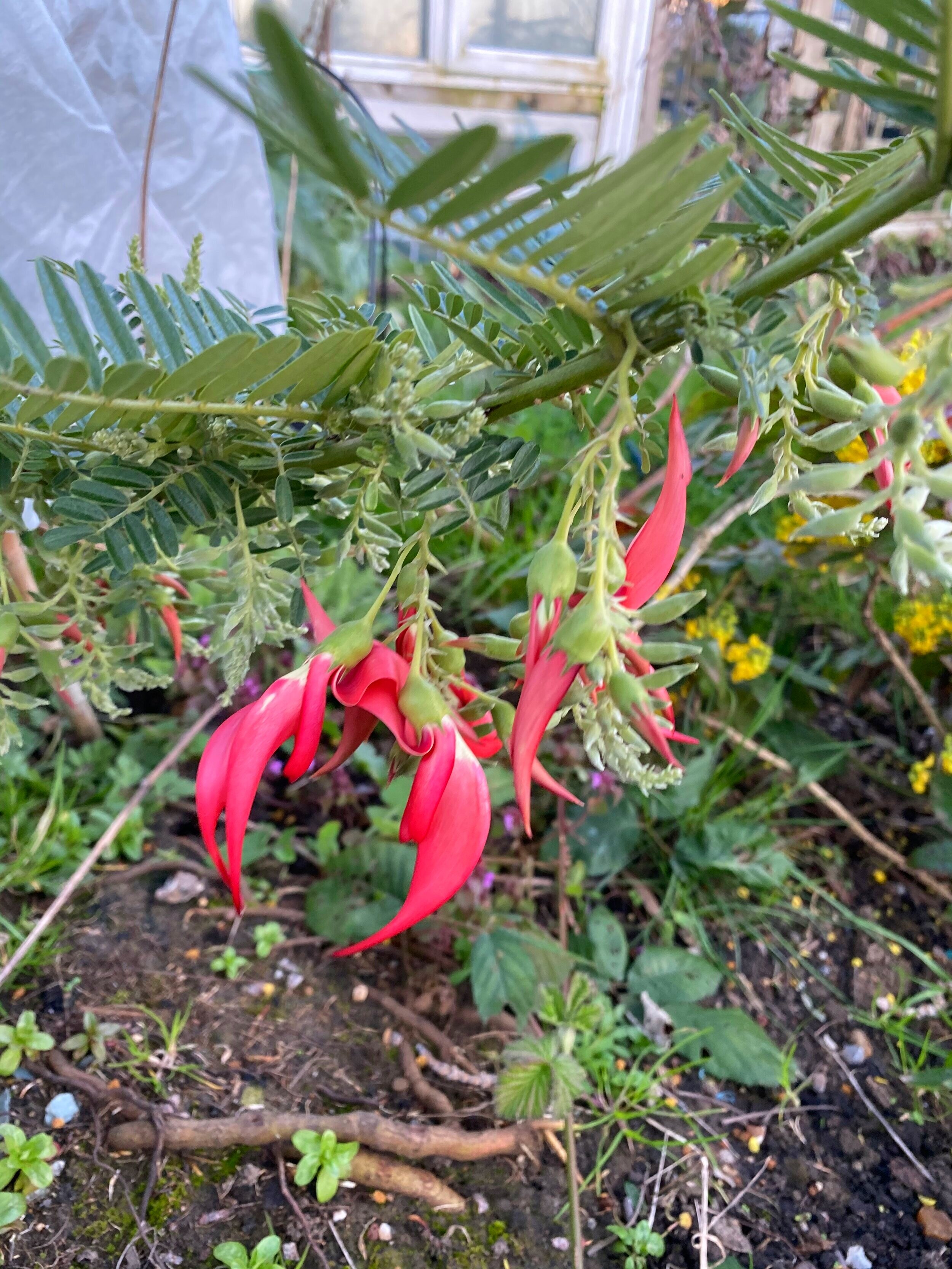The very beautiful Kōwhai ngutukākā
Kōwhai ngutukākā, botanical name Clianthus, is an scandent, evergreen flowering shrub and a member of the pea family Fabaceaea. It is a New Zealand native, where the Maori call it kakabeak (kōwhai ngutukākā ). Kaka is the name of a New Zealand parrot whose beak the flower is thought to resemble. Clianthus bears pendulous clusters of vivid red flowers to 7cm in length. While flowers are commonly red, there are pink and white varieties. Other names are glory pea, parrot’s beak, parrot’s bill and lobster claw – all references to the striking flowers.
There are two species in the genus Clianthus - Clianthus puniceus and Clianthus maximus. I recently learned that BOTH species are endangered in the wild. Today, Clianthus puniceus can only be found in the wild on Moturemu Island in the Kaipara Harbour of New Zealand. In a 2005 survey, only 153 plants of Clianthus maximus were found, mainly in the East Cape region. Thankfully, Clianthus is cultivated in many countries worldwide as well as in New Zealand, where it is a common garden plant. In colder climes, Clianthus is often grown in conservatories.
I have a Clianthus puniceus plant that was born and bred in the UK, and I’m thrilled that it is blooming NOW! Is is covered in flower buds as well! I hope I’ll be able to take the covers off soon, if even for a few days here and there so I can enjoy it in its full glory. And take some pictures.
I’m going to have a bit of fun and go native for the rest of this post, referring to the plant by its Maori name, kōwhai ngutukākā, only.
Kōwhai ngutukākā can grow up to 3m high, with spreading branches producing leaf stalks up to 15cm long bearing blueish-green pinnate leaves. After the glorious flowers comes the fruit, which my plant has produced in previous years, by the way. The fruit is a green pea-like pod that splits releasing the numerous hard small blotched seeds. It thrives in moist, well drained soil, in a sunny location. Kōwhai ngutukākā usually blooms from spring through to early summer in New Zealand, but can flower twice a year or even all year round. In the UK, the Royal Horticulture Society (RHS) advises that Kōwhai ngutukākā flowers in the summer. I must say that from my experience, my Kōwhai ngutukākā seems to follow the native pattern somewhat. I get flowers at least twice a year, far apart, with the second flush being significantly reduced. My plant has been covered in flower buds since February. It is flowering now and it’s early spring. Let’s see what else happens this year … I’ll take better note.
About five years ago, I bought two cultivars of Kōwhai ngutukākā, one red and the other white. The seller at the time advised frost protection and if possible, bringing indoors during the winter. The pots I kept them in were quite small. They flowered but their growth was curtailed. In autumn 2017, I moved them to the allotments (outside in pots) and sadly, my white Kōwhai ngutukākā died in the cold winter that followed. I haven’t replaced it yet.
Walking along the border of one of my plots in on a cold early spring day in 2018, I felt a distinct increase in temperature at a particular point. The spot was no more than 2.5m in length and about 1.5m in width. Weird? On one side (on my plot) was a 0.75 x 0.75 x 0.75m tank filled with soil, and on the other (a neighbour’s plot) was a homemade double-glazed greenhouse. I tested the temperature change a many times to confirm that I wasn’t just making it up. There was and IS some sort of greenhouse effect microclimate in that spot!
I decided to plant some perennials that are not quite frost hardy in the ground there. It’s been a success!
One of the plants I plated there was my surviving pink Kōwhai ngutukākā. It really needed to get out of the limiting pot it was in. It flowered sparsely but I could tell it was not a happy bunny. Today, my once severely curtailed (and I think stressed out) Kōwhai ngutukākā plant has bushed out significantly and stands at about 60cm high and 75cm wide! Remember, it can reach a height of 3m!
I still protect my Kōwhai ngutukākā with fleece until the threat of frost has passed. Just in case. So far it has weathered the winters (including last year’s Beast from the East’ snowstorm) quite well in the ground in its spot with the ultra-micro microclimate. It is under lightly covered with fleece now and I haven’t had the time to uncover it for a photo. Uncovering it will mean uncovering other plants and then covering them up again. I can do without the hassle. I also dread forgetting to put the covers back on and getting caught out by frost. I have other delicate plants growing in that area.
Fortuitously (for me, perhaps not the branch), a branch keeps popping out from under the covers as if to say ‘Hey! Take a picture of me!, so I did just that yesterday. And here it is.








